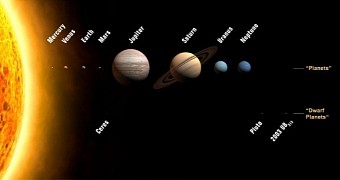On January 19, 2006, NASA's New Horizons spacecraft launched from the Cape Canaveral space station in Florida, US, and embarked on a historic journey to Pluto, a dwarf planet orbiting the Sun far, far away from us, at the edge of the Solar System.
Just a few days ago, the spacecraft fired up its Long-Range Reconnaissance Imager, which NASA scientists describe as a digital camera fitted with a large telephoto telescope, and used it to snap a couple of images of Pluto and Charon, its largest moon.
The images in question, available below, were obtained on January 25 and January 27. However, astronomers waited until yesterday to release them to the public. This is because February 4 marks the birthday of late American astronomer Clyde Tombaugh, who first spotted Pluto back in 1930.
True, the images aren't exactly NASA's best work
If we're going to be honest here, we have to admit that these two images that NASA released as a birthday tribute to Pluto discoverer Clyde Tombaugh aren't all that impressive. Heck, the images essentially show two white spots wiggling against a black background.
Then again, one must keep in mind that the New Horizons spacecraft obtained them from a distance of over 126 million miles (203 million kilometers) away. That's right, Legolas and his elf eyes ain't got nothing on New Horizons and its Long-Range Reconnaissance Imager.
Scientists say that, as it moves even closer to the Pluto system in the weeks to come, the spacecraft, now traveling at about 31,000 miles per hour (nearly 50,000 kilometers per hour) will deliver even clearer images of this distant dwarf planet and its moons.
“Pluto is finally becoming more than just a pinpoint of light. The dwarf planet will continue to grow larger and larger in the images as New Horizons spacecraft hurtles toward its targets,” explains Hal Weaver, New Horizons project scientist at the Johns Hopkins University Applied Physics Laboratory (APL) in Laurel, Maryland.
Great things await the New Horizons spacecraft
Later this year, on July 14, NASA's New Horizon's spacecraft is expected to complete a flyby of the Pluto system. During this flyby, the probe will come within just 7,700 miles (about 12,400 kilometers) of the dwarf planet and the moons circling it.
During this flyby, the spacecraft will collect data concerning the makeup of Pluto's atmosphere and try to determine whether its accompanying moon Charon has a layer of gases covering its surface as well. When finally reaching the dwarf planet and its neighbors, New Horizons will officially become the first probe ever to study this distant system in detail.

 14 DAY TRIAL //
14 DAY TRIAL // 

